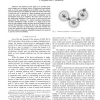Free Online Productivity Tools
i2Speak
i2Symbol
i2OCR
iTex2Img
iWeb2Print
iWeb2Shot
i2Type
iPdf2Split
iPdf2Merge
i2Bopomofo
i2Arabic
i2Style
i2Image
i2PDF
iLatex2Rtf
Sci2ools
103
click to vote
WIOPT
2006
IEEE
2006
IEEE
On the macroscopic effects of local interactions in multi-hop wireless networks
Abstract— The objective of the paper is to provide qualitative insight into the global effects of distributed mechanisms, such as carrier sense multiple access (CSMA) and rate control, on the performance and stability of multi-hop wireless networks. Toward this end, we introduce a linear queueing network model where the service capacity of each node is modulated by the transmission state of its neighbor. We derive lower bounds on the steady-state utilization at each queue of such networks and demonstrate the existence of a phase transition phenomenon, whereby infinitesimal traffic increase at a single node in the network can suddenly render the entire network instable. We also present NS simulation results that show how this phenomenon can actually take place in IEEE 802.11 multi-hop wireless networks. Our results have direct bearing on rate control schemes, in that they indicate a minimum admissible threshold rate required to prevent network instability.
Carrier Sense Multiple Access | Multi-hop Wireless Networks | Rate Control | WIOPT 2006 | Wireless Networks |
Related Content
| Added | 12 Jun 2010 |
| Updated | 12 Jun 2010 |
| Type | Conference |
| Year | 2006 |
| Where | WIOPT |
| Authors | Venkatesh Saligrama, David Starobinski |
Comments (0)

